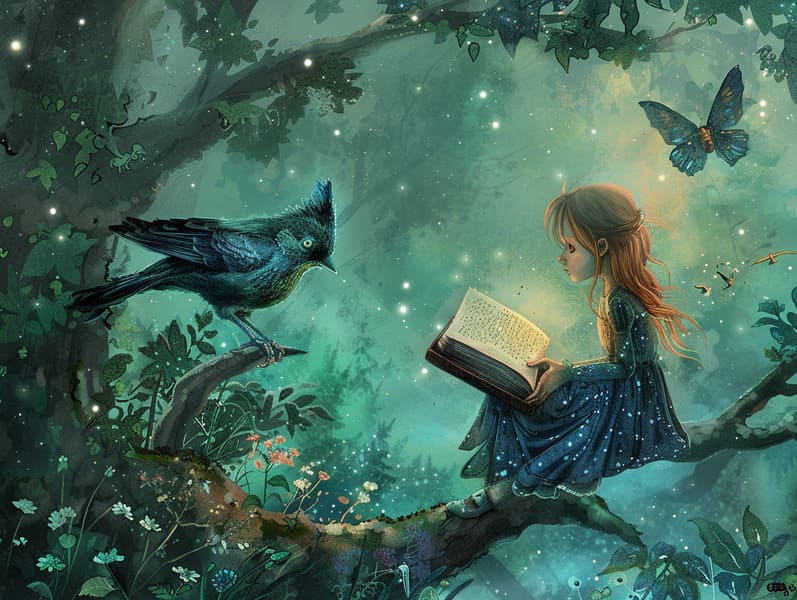
Grimm's fairy tales have old origins. These narratives have been relayed from one generation to the next ages before they were ever recorded. They came from a variety of cultures, including Middle Eastern traditions. They were initially narrated among older generations, often carrying themes and messages pertaining to the societal norms and beliefs of the time.
The renowned Brothers Grimm, Jacob and Wilhelm, were among the first to gather many of these beloved stories. Their compilation, "Grimm's Fairy Stories," included narratives like "Ashenputtel," "Hansel and Grethel," and "The True Story of Snow White," which have since become classics in the world of beloved fairy tales. Similarly, Hans Christian Andersen's imaginative tales, such as "The Mermaid," and "The Duckling's Story," have floated into hearts worldwide, securing their place in the pantheon of famous fairy tales.
Though they are centuries old, traditional fairy tales remain as important as ever, especially as children's bedtime stories. These enchanting tales are now available in different formats, including artistically illustrated books, whimsical animations, and free fairy tales online.
Their lasting presence can be connected to several fascinating points:
Crucial Morals: Classic fairy tales often present important moral lessons. Stories like "The Wolf and the Liar" teach the importance of honesty, while "The Story of the Tortoise and the Hare" exemplify the values of resolve and humbleness. These stories offer the young clear distinctions between right and wrong, guiding their moral compass in a kind yet important way.
Compassion and Insight: Ancient fairy tales frequently involve heroes facing problems and hurdles, prompting readers to identify with their struggles and applaud their triumphs. For instance, "Beauty's Beast" teaches us the necessity of seeing beyond the surface to acknowledge the inner being of a character, building insight and insight.
Cultural Knowledge: Many fairy tales are interwoven with the cultural contexts from which they originated. Delving into these fairy tales can provide enlightening views into different backgrounds, encouraging a sense of global respect and acknowledgment.
Inventiveness and Imagination: The fanciful elements in fairy tales—enchanted lands—motivate children’s creative thoughts. These stories lead readers to supernatural realms, unleashing inventive dreams and a sense of delight that continues a lifetime.
Old fairy tales are not only charming but also educational. They provide entrancing tools in fostering various thinking and feeling skills in children. When fairy tales are recited, they strengthen language acquisition by presenting new phrases and detailed sentence structures. This practice also fosters listening skills and attention span, as little ones remain attentive, keen to see what happens next.
Furthermore, discussing the themes and characters of fairy tales can strengthen thought processes and problem-solving abilities. Kids are shown to detect patterns, make predictions, and grasp cause and effect. These analyses also contribute to kids utter their thoughts and feelings, enhancing their emotional intelligence.
In today’s cyber age, the presence of online storybooks has made these narratives more within reach than ever. Online resources and apps make available comprehensive collections of ancient fairy tales that can be seen or played anytime, anywhere. Fairy tales read aloud are particularly well-liked, making available an captivating way for young readers to take part in these captivating stories. Spoken stories and voiced videos transport characters and settings to life, often augmented by delightful harmonies and instrumentals that enhance the tale-telling adventure.
The everlasting appeal of timeless fairy tales lies in their ability to adjust to today's world while keeping their essential themes. Contemporary revisions of these fairy tales often present more diverse protagonists and modern settings, making them meaningful to today’s audience. However, the essential messages of valor, humanity, and fairness remain unchanged, continuing to impact readers of all ages.
Fairy tales also offer a sense of coziness and comprehensibility. They grant a well-structured narrative with a clear beginning, middle, and end, often winding up with the culmination of conflicts and the triumph of good over bad. This consistency can be solacing for more info the young, furnishing a sense of invariability in an inconstant world.
Timeless fairy tales continue to captivate and teach new generations, maintaining their splendor and applicability in modern society. As kids' bedtime tales, they present to a perfect blend of magic and knowledge, backing moral values, empathy, and creativity. The availability of web-based fairy tales and the widespread nature of fairy tales voiced guarantee that these ancient stories remain within reach to new generations.
By sustaining and telling these fairy tales, we continue to exalt the rich tapestry of legends and cultural heritage. Whether you are reading a gorgeously illustrated book, accessing a cyber library, or playing an spoken story, the appeal of bedtime fairy tales is always within reach. These narratives emphasize of the unceasing ability of narratives and its ability to bond us across centuries and lands.
Even if you are seeing a artistically illustrated book, exploring a online collection, or playing an spoken story, the charm of traditional fairy tales is always within reach.
These stories point out of the ageless impact of storytelling and its ability to link us across generations and cultures, making a tie that fascinates and enlightens alike.